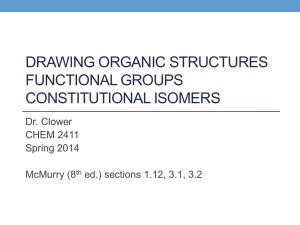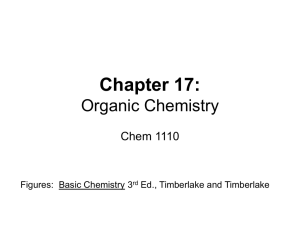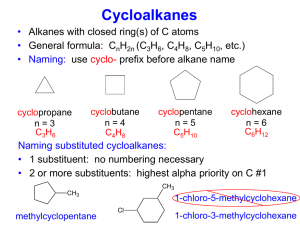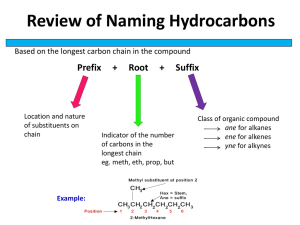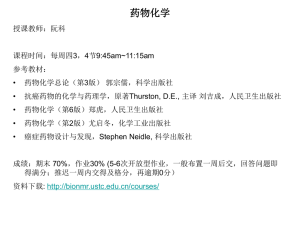What is Organic Chemistry
advertisement
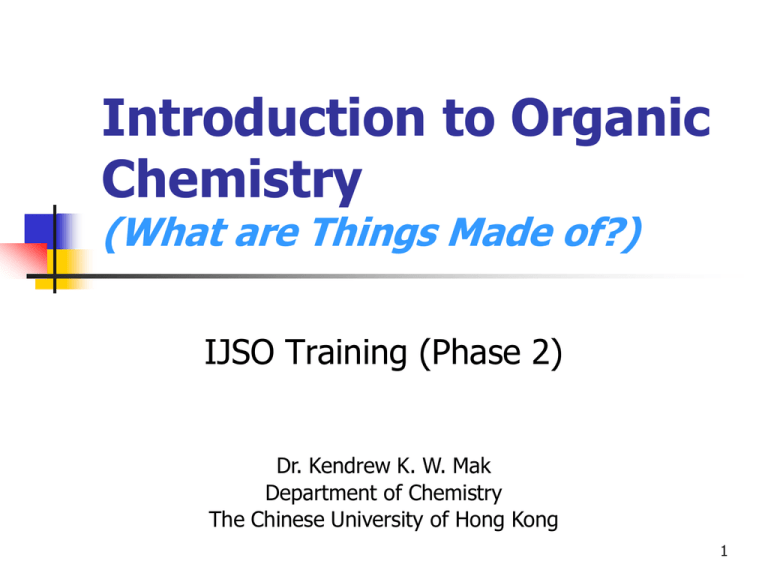
Introduction to Organic Chemistry (What are Things Made of?) IJSO Training (Phase 2) Dr. Kendrew K. W. Mak Department of Chemistry The Chinese University of Hong Kong 1 Roles of Organic Chemistry in Daily Life Organic compounds (有機化合物) can be found in: Detergents (清潔劑) Pesticides (農藥 / 殺蟲劑) Gasoline (汽油) / Fuels (燃料) Paints Dyes (染料) Medicines Computers / Communication products Living organisms Food Plastics / polymers (塑膠 / 聚合物) and a lot more …… 2 What is Organic Chemistry (有機化學) Classical Definition Compounds obtained or derived from living organisms Modern Definition Compounds that are made up of carbon atoms. About 13 million organic compounds are known today. About 100,000 new ones discovered every year. There are only 200,000 to 300,000 known inorganic compounds (those are made up of elements other than carbon) 3 Interesting Organic Compounds – Compounds having favorable aromas O H O CH 3 OH Vanillin (香草醛) N N Tetramethylpyrazine (川芎嗪) 4 Organic Compounds Natural Organic Compounds Proteins (蛋白質), enzyme (酵), vitamins (維生素), lipids (脂質) , carbohydrates (碳水化合物), nucleic acid (核酸) …… Synthetic (Man-made Compounds) Synthetic fabrics (合成織品), plastics (塑膠), synthetic rubber (合成 橡膠), medicine (藥物) , adhesives (黏合劑), photographic film (攝影 菲林) …… 5 Diversified Structures O H 3C CH 3 H H H H C C O H H O O O NH O O OH O (CH 3 CH 2OH) OH HO O OO OH HO HO O OH O O O OH O OH OH OH Complex Simple 6 Hydrocarbons – Contain only Carbon and Hydrogen Atoms Organic compounds that contain only carbon and hydrogen are called hydrocarbons (碳氫化合物). Hydrocarbons differ from one another in the number of carbon atoms present in one molecule, and the ways that they are bonded together. Methane (甲烷) has one carbon atom, and octane (辛烷) has eight. Polyethylene (聚乙烯) contains hundreds to thousands of carbon and hydrogen atoms in each molecules. Methane (CH4) Octane (C8H18) Polyethene 7 Molecular Sizes and Properties Physical Properties of Some Alkanes (烷烴) Name Molecular Formula Methane CH4 -182 -164 Gas Ethane C2H6 -183 -89 Gas Propane C3H8 -190 -42 Gas Butane C4H10 -138 -1 Gas Pentane C5H12 -130 36 Liquid Hexane C6H14 -95 69 Liquid Heptane C7H16 -91 98 Liquid Octane C8H18 -57 125 Liquid Nonane C9H20 -51 151 Liquid Decane C10H22 -30 174 Liquid Melting Point (°C) Boiling Point (°C) Physical State (At 20°C) 8 Structural Isomers of Hydrocarbons Hydrocarbons also differ from one another in the way the carbon atoms bonded to each other. HH H C HH C H H C C C HH H H H H n-Pentane, C5H12 Straight chain (直鏈) H C C H H C C H HH H H H H H C H H H C H iso-Pentane, C5H12 C H H H C C H H C HH H neo-Pentane, C5H12 Branched chains (支鏈) 9 Structural Isomers of Hydrocarbons Boiling Point. 36°C n-Pentane, C5H12 iso-Pentane, C5H12 30°C The number of possible structural isomers (異構體) of a chemical formula increases rapidly as the number of carbon atoms increases. C5H12 C8H18 C20H42 3 isomers 75 isomers 366,316 isomers 10°C neo-Pentane, C5H12 10 Conformers – Same Molecule with Different Spatial Orientations 11 Petroleum (石油) – Major Source of Hydrocarbon Petroleum (also known as crude oil) is a complex mixture consisting mainly of alkanes. It corresponds to the fossil (化石) remains of microscopic animals that lived in the seas in ancient times. Fractional distillation (分餾) 12 Alkane – The Simplest Form of Hydrocarbon Methane (CH4) Natural Gas Biogas (marsh gas) H3C H2 C C H2 CH3 H H C H H Butane (丁烷) (C4H10) Liquefied petroleum gas (液化石油氣)(LPG) Lighter gas 13 Alkane – The Simplest Form of Hydrocarbon H3C H2 C C H2 H2 C C H2 H2 C Octane Number (辛烷值) CH3 0 Heptane H3C H3C CH3 CH3 C C H2 CH CH3 100 2,2,4-Trimethylpentane 14 Boosting Up the Octane Number Anti-Knocking Agent (抗震劑) Tetramethyl lead (四甲基鉛), Pb(CH3)4 Tetraethyl lead (四乙基鉛), Pb(C2H5)4 Benzene C6 H 6 Toluene C7 H 8 p-Xylene C 8H 10 Octane No. = 106 Octane No. = 118 Octane No. = 116 Toxic – leukemia (白血病) Cause air pollution Produce smog (煙霧) 15 Saturated and Unsaturated Hydrocarbons Saturated Hydrocarbons – contain single bonds only Unsaturated Hydrocarbons – contain multiple bonds Saturated hydrocarbon (飽和碳氫化合物) H H H C H C H H H H H C H n-Butane, C4H10 (丁烷) H C C H H Unsaturated hydrocarbon (不飽和碳氫化合物) H C C H H C H H But-2-ene, C4H8 (丁-2-烯) 16 Alkenes – Hydrocarbons with C=C Double Bonds Ethene/Ethylene (乙烯) (C2H4) – The simplest alkene (烯) H H C C H H Use: Making polymer (polythene) A plant hormone (triggers fruit ripening) beta-carotene (胡蘿蔔素) Beta-carotene is the precursor molecule to vitamin A 17 Alkenes – Hydrocarbons with C=C Double Bonds H H H C C C H H C H H H H C H C H H H H H H H H C C C C C C H H H H H H Polymerization (聚合作用) H H H H H H H H H H C C C C C C C C C C H H H H H H H H H H 18 Sigma (s) Bond and Pi (p) Bond Compounds with double covalent bond Pi (p) – side-to-side overlap Ethene (CH2=CH2) Double covalent bond = 1 s bond + 1 p bond H 1.08Å 121.7° C H C 116.6° H 1.33Å H A double bond consists of one σ bond and one p bond 19 Geometrical Isomers (幾何異構體) of Alkene H3C H CH3 H H3C H H CH3 cis-2-butene trans-2-butene (順-丁-2-烯) (反-丁-2-烯) 20 C=C Double Bonds: Absorption of Light Compound H2C CH2 UV-C: UV-B: UV-A: Visible light: below 280 nm 280 nm – 320 nm 320 nm – 400 nm 400 nm – 700 nm max (nm) (M-1cm-1) 165 15,000 217 21,000 256 50,000 290 85,000 334 125,000 364 138,000 1 nm = 10-9 m 21 Sunscreens (防曬霜) not very soluble in oily skin lotions O OH (CH 3 )2N H2 N O CH 2CH3 COCH2 CHCH2 CH2 CH 2CH 3 para-aminobenzoic acid PABA 2-ethylhexyl 4-(dimethylamino)benzoate Padimate O absorb UV-B absorb UV-B O CH2 CH3 OCH2 CHCH2 CH 2CH 2CH3 CH 3O 2-ethylhexyl (E)-2-(4-methoxyphenyl)-2-propenoate Giv Tan F absorb UV-A & UV-B 22 C=C Double Bonds: Absorption of Light -carotene (胡蘿蔔素) max = 455nm carrots, apricots, sweet potatoes (orange) lycopene (番茄紅素) max = 474nm tomatoes, watermelon, pink grapefruit (red) 1 nm = 10-9 m 23 Benzene and Aromatic Compounds The electrons of the double bonds in benzene (苯) are not confined between any two carbon atoms. These electrons are able to move freely around the ring. some common aromatic compounds (芳香族化合物): Cl Cl Toluene Naphthalene 1,4-Dichlorobenzene 24 The Delocalization of Electrons in Benzene H 6 C 5 H C 4 H 1 C C H C2 C 3 H H H H H 1 C 6 C 5 C 4 C C2 C 3 H H H I II Resonance structures (共振結構) of benzene H C C H C 154 nm H C H H C133 nm C H H H C C H C C H H C 140 nm C H 25 The Delocalization of Electrons in Benzene • A compound with delocalized electrons is more stable than it would be if all of its electrons were localized. • The extra stability a compound gains from having delocalized electrons is called delocalization energy (離域能) or resonance energy (共振能) . Potential energy “cyclohexatriene” + 3H2 benzene + 3H2 H° = -85.8 kcal/mol (-359kJ/mol) 36 kcal/mol (151kJ/mol) H° = -49.8 kcal/mol (-208kJ/mol) cyclohexane 26 Delocalization (離域作用) – Two More Examples Delocalization in the carbonate ion OO C O- OO- C O O O- C O- 2/3 - O O C 2/3 O 2/3 - Resonance Hybrid Resonance Structures Bonding in ethanoic acid and the ethanoate ion 127 pm 124 pm O H3C C OH 143 pm Only one structure for the acid O H3C C O- OH3C C O Two equivalent resonance structures for the anion 1/2 - O H3C C O1/2 127 pm Resonance Hybrid 27 Organic Molecules are Classified by Functional Groups Ethane (C2H6) Boiling point = - 88°C A gas at room temperature Insoluble in water. H H H H C C O H H Ethanol (C2H5OH) Boiling point = + 78°C A liquid at room temperature Soluble in water For making alcoholic beverages H H H H C C N H H H Ethylamine (C2H5NH2) A corrosive (腐蝕性), pungent (刺激性), highly toxic gas H H H C C H H H 28 Organic Molecules General are Classified Structure by Functional C OH Groups C C C Name Class Hydroxyl group Alcohols Phenolic group Phenols Ether group Ethers Amine group Amines Ketone group Ketones Aldehyde group Aldehydes Amide group Amides Carboxyl group Carboxylic acids Ester group Esters C OH C C C O C Function group (官能基) is defined as a combination of atoms that behave as a unit. C N O C C O C O C O C O C C H N OH O C 29 Alcohols Contain the Hydroxyl Group Alcohols are organic molecules in which a hydroxyl group is bonded to a saturated carbon. H H H C O H Methanol (甲醇) • Making methylated spirit • Fuel for racing car OH H 3C C CH 3 H Isopropanol (異丙醇) • Rubbing alcohol 30 Alcohols Contain the Hydroxyl Group H H H C C OH H H Ethanol Fermentation (發酵作用) (C6H10O5)x Starch enzymes C6H12O6 Glucose enzymes 2 CH3CH2OH + 2 CO 2 Ethanol 31 Transformation of Function Groups Conversion of alkenes to alcohols (hydration水合作用) H+ + CH3CH CH2 H2O heat propene CH3CH CH2 OH H 2-propanol An acid-catalyzed reaction without H + CH3CH CH2 + H 2O No reaction propene 32 Interconversion of Alcohols and Alkyl Halides CH3OH + HBr heat CH3Br + H2O bromomethane CH3Br + OH- CH3OH + Br- 33 Some Common Halogenated Hydrocarbons Some Halogenated Hydrocarbons Formula Common name CH3Cl Methyl chloride CH2Cl2 IUPAC name Derived from methane Some important uses Chloromethane Refrigerant; manufacture of silicones, methyl cellulose, and synthetic rubber Methylene chloride Dichloromethane Laboratory and industrial solvent CHCl3 Chloroform Trichloromethane Industrial solvent CCl4 Carbon tetrachloride Tetrachloromethane (see text) CBrF3 Halon-1301 Bromotrifluoromethane Fire extinguisher systems CCl2F2 CFC-12 Dichlorodifluoromethane Refrigerant CH3CH2Cl Ethyl chloride ClCH2CH2Cl CCl3CH3 Derived form ethane Chloroethane Local anesthetic Ethylene dichloride 1,2-dichloroethane Solvent for rubber Methylchloroform 1,1,1-trichloroethane Solvent for cleaning computer chips and molds for shaping plastics 34 Reactions of Alcohols and Halogenated Hydrocarbons CH3CH2OH + CH3CH2Cl CH3CH2OCH2CH3 Diethyl ether Diethyl ether was used as an anesthetic (麻醉劑) starting from mid-19th century. A commonly used laboratory solvent. MTBE as fuel additive (燃料添加劑) O Methyl tert-butyl ether (MTBE) • It burns very completely and reduces the emission of carbon monoxide. • Very high octane rating (116), replace aromatic hydrocarbons • Very strong odor, sickening to some people. • Decompose very slowly in nature, polluting the environment. 35 Different Types of Isomers Isomers Structural Isomers (結構異構體) (Different bonding) Stereoisomers (立體異構體) (Different shapes) Positional Isomers Hydrocarbon Chain Isomers Functional Group Isomers Geometric Isomers Enantiomers (Optical Isomers) 位置異構體 碳氫鏈異構體 官能基異構體 幾何異構體 對映異構體 (旋光異構體) 36 Different Types of Isomers Positional Isomers Hydrocarbon Chain Isomers Functional Group Isomers Br Br Br OH OH OH O OH C5H11Br C4H9OH C4H10O 37 Different Types of Isomers Geometric Isomers Enantiomers (Optical Isomers) H3C CH3 H3C CH3 C4H8 (See next page……) 38 Optical Isomers and Chiral Compounds Asymmetric Carbon (不對稱碳原子) – is a carbon atom that bonded to four different groups An asymmetric carbon can be known as a chiral (手性) center * CH3CHCH2CH3 Br 2-bromobutane Br H3CH2C C Br H H3C H CH3 C CH2CH3 mirror the two isomers of 2-bromobutane enantiomers (對映異構體) 39 Conversion of Alcohols to Aldehydes (醛) liver enzymes CH3OH H H Formaldehyde LD50 = 0.070 g Methanol CH3CH2OH Ethanol Very toxic O C liver enzymes CH3 O C The aldehyde group H Acetaldehyde Less toxic LD50 = 1.9 g Oxidation Reaction (氧化反應) 40 Some Common Aldehydes O • Large amounts of formaldehyde are used for producing adhesives for making plywood (夾板). • Embalming (防腐) H C H Formaldehyde (甲醛) 41 Some Common Aldehydes Aldehydes Structure Vanillin O C (香草醛) Food that contain the aldehydes Vanilla Ice-cream H HO O Benzaldehyde (苯醛) Cinnamaldehyde (肉桂醛) CH 3 O C Almond H O H C H C C H Cinnamon 42 From Wine to Vinegar CH3CH2OH oxidation CH3COOH Ethanol Acetic acid an alcohol a carboxylic acid White vinegar – 5% acetic acid solution O OH Carboxyl group 43 Carboxylic Acids Found in Foods AHAs Alpha-hydroxy acids AHAs contain a hydroxyl group (-OH) bonded to the first carbon atom attached to the –COOH group. HO O OH OH O C CH CH C HO OH Tartaric acid O OH O C CH CH2 C Malic acid O HO C CH CH 3 O OH HO C OH CH 2 C O O CH 2 C OH C OH Lactic acid OH Citric acid 44 Reactions of Carboxylic Acids with Alcohols CH3CH2CH2 O C butyric acid CH3 O C OH + H+ CH3CH2OH CH3CH2CH2 ethanol OH acetic acid pentanol OCH2CH3 + H2O ethyl butyrate (pineapple favour) + + CH3CH2CH2CH2CH2OH O C H CH3 O C OCH2CH2CH2CH2CH3 + H2O pentyl acetate (banana favour) O C O ester linkage (酯鍵合) 45 Some Esters (酯) and Their Odors Name Structure Odor Ethyl formate HCOO—CH2CH3 Rum Isobutyl formate HCOO—CH2CH(CH3)2 raspberry Ethyl acetate CH3COO—CH2CH3 Floral Propy acetate CH3COO—CH2CH2CH3 Pear Pentyl acetate CH3COO—CH2CH2CH2CH2CH3 Banana Isopentyl acetate CH3COO—CH2CH2CH(CH3)2 Banana Octyl acetate CH3COO— CH2CH2CH2CH2CH2CH2CH2CH3 Orange Benzyl acetate CH3COO—CH2C6H5 Jasmine Isobutyl propionate CH3CH2COO—CH2CH(CH3)2 Apple Methyl butyrate CH3CH2CH2COO—CH3 Rum Ethyl butyrate CH3CH2CH2COO—CH2CH3 Pineapple Butyl butyrate CH3CH2CH2COO—CH2CH2CH2CH3 Pineapple Amyl butyrate CH3CH2CH2COO—CH2CH2CH2CH2CH3 Apricot Isoamyl pentanoate CH3CH2CH2CH2COO—CH2CH2CH(CH3)2 Apple 46 More About Oxidation and Reduction Reactions H H H C O H Methanol - "2 H" oxidation H O C + "O" H oxidation Formaldehyde H O C O H Formic acid Oxidation (in organic chemistry) – often refers to: • gaining oxygen atoms (+ O) • losing hydrogen atoms (- H) oxidation – 氧化作用; reduction – 還原作用 47 More About Oxidation and Reduction Reactions H O C + "2 H" H reduction Formaldehyde H O C O H Formic acid H H H C O H Methanol + "2 H", - "O" reduction H H H C O H Methanol Reduction (in organic chemistry) – often refers to: • losing oxygen atoms (- O) • gaining hydrogen atoms (+ H) 48 More About Oxidation and Reduction Reactions H H H H H C C C O H H H oxidation H H O H C C C H H H 1o alcohol H H O H H C C C H H H H 2o alcohol CH3 H H3C C O CH3 3o alcohol aldehyde oxidation H C H H O C oxidation H H O H C C C H H O H carboxylic acid H C H H ketone Not easily oxidized No H attached to the "C" atom 49 Amines (胺) and Amides (酰胺) Amines – substances with “fishy” smell. CH3 NH 2 CH 3CH 2 NH 2 primary (1o ) amine H3 C N CH 3 H3 C H3 C N H H3 C secondary (2o ) amine tertiary (3 o) amine Amides – linking the amino acids in proteins O H N S H2N O O N H H N O N H OH O H N O N H O HO H N O O N H NH H N N N O OH NH2 50 Organic Chemistry in Daily Life • Polymers & Plastics (聚合物及塑膠) • Detergents (清潔劑) 51 What is Polymer? Polymer – substances that contain very long molecular chains and have the same structural unit repeating over and over again. Examples of natural polymers – cotton, silk and rubber. cotton clothes made from silk tire made of rubber 52 Natural polymers Cotton – mainly composed of cellulose (纖維素). OH OH OH O HO HO HO OH OH HO O OH OH H O O O H OH HO HO OH H n-2 O OH H cellulose H -D-glucose Silk – natural protein fiber H3C CH C OH NH2 alanine O O O H CH C OH NH2 glycine H2C CH C OH OH NH 2 serine Rubber – formed from the polymerization of isoprene (異戊二烯) ...... ...... n isoprene polyisoprene 53 Addition Polymerization (加成聚合作用) The two major ways of making polymers: addition polymerization and condensation polymerization. Addition polymerization – joining the monomers together without losing any small molecule or atom. Examples are Polythene (PE) n (聚乙烯) Polystyrene (PS) H H C C H n H addition polymerization H H C C H addition polymerization H H C C H H n H H C C H n (聚苯乙烯) Monomer (單體) – low molecular weight compound that can be connected together to give a polymer 54 Condensation Polymerization (縮合聚合作用) Condensation polymers are formed by condensation (縮合作用) reactions, in which small molecules such as water or hydrogen chloride are eliminated in the polymerization process. Examples are O Nylon n OH HO + n H2N NH2 O O H N N H n O Polyethylene terephthalate (PET) HO + 2n H2O OH n O OH n HO + O (聚對苯二甲酸乙二酯) O “ A polyester – 聚酯” O O O n + 2n H2O 55 Thermoplastics (熱塑性塑膠) Thermoplastics The polymer molecules are held together by the weak intermolecular van Der Waals forces (范德華力). At elevated temperature, it is easy to "melt" these bonds and the molecular chains can slide past one another easily. These polymers can be soften or melted by heating, and can be remolded into different forms. polymer strands original form have little tendency to return to its original form The chain can be stretched, which cause them to flow pass each other, When released, the polymer will not return to its original form. 56 Thermosetting Plastics (熱固性塑膠) Thermosetting Plastics These are three-dimensional polymers which are highly cross-linked by strong chemical bonds such as covalent bonds. Thermosetting polymers are “set” or “polymerized” through chemical reactions to form the cross-links (交 鍵). Once the chemical reaction or polymerization is complete, the polymer becomes a hard, infusible, insoluble material which cannot be softened, melted or molded. 57 Soaps and Detergents (肥皂及清潔劑) Water is a poor cleaning agent: • Water has high surface tension (表面張力). It tends to form beads and droplets, and does not wet substances very well. • It cannot dissolve greasy dirt effectively. Soap cleans by: • Decreasing water’s surface tension, making it a better wetting agent; • Converting greasy and oily dirt into small particles that become dispersed in the soapy water; • Keeping the grease particles in suspension (懸浮狀態), preventing them getting together and stick back to the clean surface. 58 The Soap Molecule Na+ or K+ Hydrophobic (疏水性) tail is attracted to oily, greasy, hydrocarbon-like substances. CH3 (CH2)n CO2- Na+ Hydrophilic (親水性) head is attracted to water molecules. n: even number, ranging from 8 - 16 a soap molecule 59 Breaking the Surface Tension 60 Removing the Greasy Dirt The soap molecules embed the hydrophobic tails into the greasy dirt and leave it off the surface. The particles (micelles) repel each other, forming many tiny suspended droplets. 61 Making of Soap : Saponification of Triglyceride Triglycerides are the principal constituents of animal fats and vegetable oils. O O CH2 O C CH2 R O CH O C R' + 3NaOH H2O Heat R OH O C O- Na+ O CH OH + R' C O-Na+ O O CH2 C R" CH2 A triglyceride OH Glycerol R" C O-Na+ Soaps The saponification of a triglyceride. R, R’ and R”: Straight (unbranched) hydrocarbon chains. saponification – 皂化作用; triglyceride – 甘油三酸酯 62 Soap and Hard Water (硬水) Hard water: • • high mineral content rich in calcium ions (Ca2+) and magnesium ions (Mg2+) Soap forms insoluble precipitates (soap curd) with hard water. It reduces the cleaning power of soap. 2 CH3 (CH 2) nCO2 - Na + + Ca2+ aqueous solut ion 2 CH 3 (CH2 )n CO 2- Na+ aqueous solution precipitate – 沉澱物 (CH 3(CH 2) nCO2 -) 2 Ca 2+ insoluble pr ecipitat es + Mg2+ (CH3 (CH2 )n CO2- )2 Mg 2+ insoluble precipitates 63 Soapless Detergent (非皂性清潔劑) Replace the anionic carboxylate group with a sulfonate group. Alkyl sulfonates do not form insoluble salts in hard water. O O S - + O O Na Sodium lauryl sulfate (SLS) or sodium dodecyl sulfate (SDS) R SO3- Na+ R = alkyl group Sodium alkylbenzenesulfonate 64

